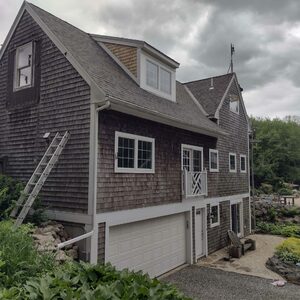*
Water Wins Again. I built a deck with the ledger lag screwed to the rim joist at the rear of the house. My home features an “English Basement” that is half above and half below grade. At the rear of the house, there’s an OSB sheathed stick wall that’s about 4 feet high below the rim to which the deck is attached. The problem: after examining installations on other decks in my neighborhood, I installed the ledger atop vinyl siding rather than directly against the rim joist. Confident that the caulking I applied would obviate water infiltration near the bolt holes in the siding, I completed the deck. No flashing was installed over the ledger.
Last night, I found out how big a mistake this was. I had to get into one of the rear basement wall interior stud bays below the deck, and upon removing the foil wrap and insulation, I discovered wet, discolored, moldy sheathing. This condition exists to varying degrees in most of the 2×6 bays below the deck. Aside from the “I knew better” feeling I have, I need to correct this situation. Reviewing construction pictures, I know that the house wall at the rim consists of two joists faced with OSB on the outside. One more confession – I’m not a tradesman, as if you hadn’t already figured that out.
I’m looking for suggestions on how to deal with this situation. I haven’t been able to inspect anything immediately behind the ledger for obvious reasons. After bracing everything appropriately, I might be able to detach the deck from the house by removing the lag screws and all of the joist hanger nails. I may be able to work the siding free after this step, but without wider access, I won’t have much working room for inspection or repair. I would like to avoid removing a major portion of the deck. I could totally remove the ledger only by removing half of the deck joists (running perpendicular to the deck). My thought here, if this step is absolutely necessary, is to cut a section from each joist so as to allow for ledger removal, and then later sister a new joist section to restore the cut joists to bearing capacity. Removing all the joist hangars seems like an impossibility. In this case, once I had access, I’d repair any water damage and do the proper ledger install.
I’d appreciate any help I can get on solving this problem. Other than this screw-up, the deck is sound an is performing like it should.



















Replies
*
Anytime I have seen plain bolting to the siding as recommended, there must be a spacer between the ledger and the siding, ie a stack of stainless steel fender washers. If not, water is going to sit in the junction and eventually get inside.
*Hi Tom,That "English basement" is known as a dungeon. You have to perform the re work so as to remedy the problem. Your post says that much.You'll probably have to erect a temporary wall to support the deck while the repairs are made. Then you'll be safe to make the detachment. You'll need a catspaw and sawzall. Work safe. good luck,Dan-O
*Why not go ahead and instal new supports for the deck at the house end, and omit the connection to the house all together?
*
Water Wins Again. I built a deck with the ledger lag screwed to the rim joist at the rear of the house. My home features an "English Basement" that is half above and half below grade. At the rear of the house, there's an OSB sheathed stick wall that's about 4 feet high below the rim to which the deck is attached. The problem: after examining installations on other decks in my neighborhood, I installed the ledger atop vinyl siding rather than directly against the rim joist. Confident that the caulking I applied would obviate water infiltration near the bolt holes in the siding, I completed the deck. No flashing was installed over the ledger.
Last night, I found out how big a mistake this was. I had to get into one of the rear basement wall interior stud bays below the deck, and upon removing the foil wrap and insulation, I discovered wet, discolored, moldy sheathing. This condition exists to varying degrees in most of the 2x6 bays below the deck. Aside from the "I knew better" feeling I have, I need to correct this situation. Reviewing construction pictures, I know that the house wall at the rim consists of two joists faced with OSB on the outside. One more confession - I'm not a tradesman, as if you hadn't already figured that out.
I'm looking for suggestions on how to deal with this situation. I haven't been able to inspect anything immediately behind the ledger for obvious reasons. After bracing everything appropriately, I might be able to detach the deck from the house by removing the lag screws and all of the joist hanger nails. I may be able to work the siding free after this step, but without wider access, I won't have much working room for inspection or repair. I would like to avoid removing a major portion of the deck. I could totally remove the ledger only by removing half of the deck joists (running perpendicular to the deck). My thought here, if this step is absolutely necessary, is to cut a section from each joist so as to allow for ledger removal, and then later sister a new joist section to restore the cut joists to bearing capacity. Removing all the joist hangars seems like an impossibility. In this case, once I had access, I'd repair any water damage and do the proper ledger install.
I'd appreciate any help I can get on solving this problem. Other than this screw-up, the deck is sound an is performing like it should.